The White-throated Swift (Aeronautes saxatalis) stands as an avian marvel, inhabiting the rugged landscapes of western North America.
Recognized for its sleek, aerodynamic appearance, this medium-sized bird is characterized by distinctive behaviors and adaptations.
Its long, slender wings and forked tail enable unparalleled aerial prowess, making it a masterful hunter of flying insects.
Notably, the white patch on its throat sets it apart, contributing to a visually striking plumage against the backdrop of cliffs and canyons where it thrives. Social nesting in colonies, crepuscular activity, and territorial defense further distinguish the White-throated Swift.
As a species emblematic of adaptability and precision in flight, exploring its life history’s intricacies unveils a captivating survival narrative in challenging environments. Stay sharp.
How to Identify White-throated Swift?
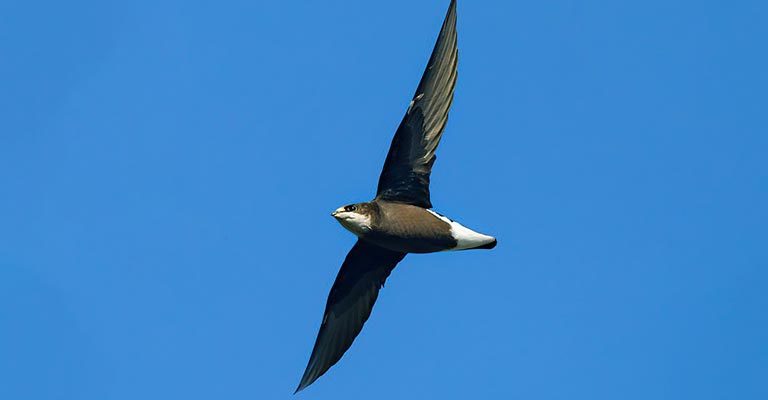
The White-throated Swift (Aeronautics saxatile) is a distinctive and fascinating bird in western North America.
Identifying this species requires a keen eye and attention to specific features. Here are some key points to help you recognize the White-throated Swift:
Distinctive Appearance
White-throated Swifts are medium-sized birds with a unique appearance. They have long, slender wings, a short tail, and a streamlined body.
The plumage is predominantly black or dark brown, contributing to their sleek and aerodynamic look. The most striking feature is the white patch on the throat, a key identifier for this species.
White Throat Patch
As the name suggests, the most defining characteristic of the White-throated Swift is the white patch on its throat.
This patch contrasts sharply with the dark plumage, creating a visually striking and easily identifiable feature. The white throat is particularly noticeable during flight or when the bird is perched.
Swift Flight
White-throated Swifts are known for their swift and agile flight. They have a distinctive flight pattern characterized by rapid wing beats and sharp, direct movements.
Their flight is often described as erratic, making them stand out from other bird species. Observing their flight behavior is crucial for accurate identification.
Forked Tail
Pay attention to the tail of the White-throated Swift, which is short and forked. The tail shape is essential when distinguishing it from other similar-looking birds.
The forked tail enhances their maneuverability in flight and is a crucial adaptation for their aerial lifestyle.
Habitat Preference
The bird’s habitat can aid in identification. White-throated Swifts prefer rocky cliffs, canyons, and other rugged terrains for nesting and roosting.
These birds are often found in arid and mountainous regions, making their habitat preferences another clue for identification.
Vocalizations
While not as distinctive as some bird species, White-throated Swifts produce vocalizations.
Their calls are high-pitched and chattering, often heard during flight or while the birds socialize. Familiarizing yourself with their vocalizations can be an additional tool for identification.
Group Behavior
White-throated Swifts are social birds and often gather in flocks, especially during the breeding season.
Observing their group behavior, such as flying together in coordinated patterns, can help confirm the identification. They engage in aerial displays and acrobatics as part of their social interactions.
Range and Migration
Understanding the geographical range of White-throated Swifts is essential for accurate identification. They are primarily found in western North America, from southern Alaska to Baja California.
Additionally, they are known to undertake seasonal migrations, with some populations moving to lower elevations during winter. Being aware of their range and migration patterns can assist in confirming the identification of these birds.
Recognizing the White-throated Swift involves a combination of visual cues, behavioral observations, and awareness of their specific habitat and range.
Considering these key points will enhance your ability to identify this unique and captivating bird species in the wild.
Taxonomy of White-throated Swift
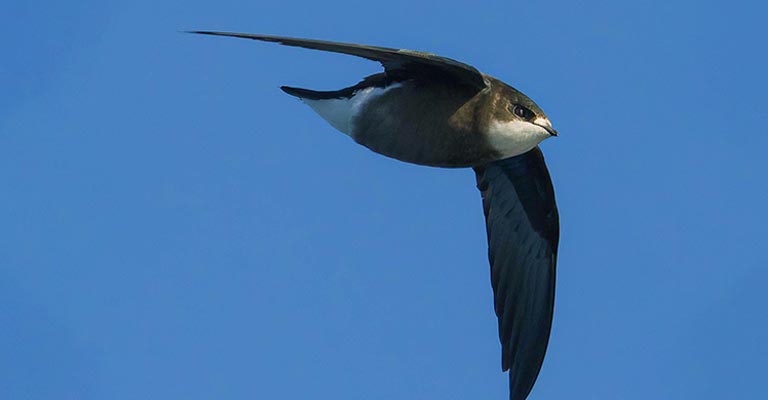
Check out the table below summarizing the taxonomy details of White-throated Swift:
| Taxonomic Level | Classification |
| Domain | Eukaryota |
| Kingdom | Animalia |
| Phylum | Chordata |
| Class | Aves |
| Clade | Strisores |
| Order | Apodiformes |
| Family | Apodidae |
| Genus | Aeronautes |
| Species | A. saxatalis |
The White-throated Swift (Aeronautics saxatile) is a captivating bird species in western North America, known for its distinctive features and aerial prowess. This species comprises two subspecies: A. s. saxatalis and A. s. nigrior.
- A. s. saxatalis: The nominate subspecies, A. s. saxatalis, is the standard representation of the White-throated Swift. This subspecies is distributed across its range, which extends from southern Alaska to Baja California. Observations and studies of A. s. saxatalis contribute valuable insights into the White-throated Swift’s overall biology, behavior, and ecological preferences.
- A. s. nigrior: The subspecies A. s. nigrior, distinguished by its specific characteristics, contributes to the overall diversity within the White-throated Swift population. Found within the species’ range, this subspecies may exhibit variations in plumage, behavior, or habitat preferences. Studying A. s. nigrior aids in understanding the nuances of adaptation and evolution within different environments.
The presence of two subspecies within the White-throated Swift emphasizes the species’ ability to adapt to varied habitats and conditions across its range.
Research on these subspecies enhances our understanding of the ecological intricacies and evolutionary dynamics within the White-throated Swift population in western North America.
Hunting Habit of White-throated Swift
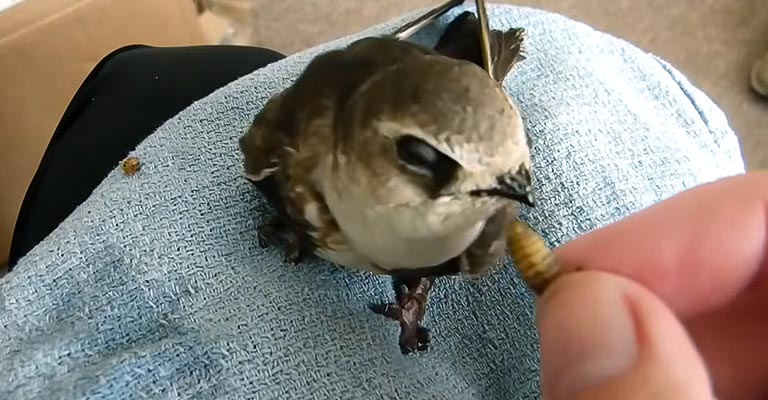
The White-throated Swift is an adept aerial hunter, relying on its remarkable flight skills to catch prey on the wing. These birds primarily feed on flying insects, such as flies, moths, and beetles.
With their swift and agile flight, they navigate through the air with precision, executing rapid twists and turns to capture insects mid-flight.
White-throated Swifts often hunt in groups, taking advantage of their social nature to locate and pursue prey more effectively.
Their specialized beaks are adapted for catching and consuming insects while in flight. These birds are crepuscular hunters, meaning they are most active during dawn and dusk, utilizing low-light conditions to enhance their hunting success.
Their exceptional flight abilities and social behavior make the White-throated Swift a formidable and efficient aerial predator.
White-throated Swift Life History
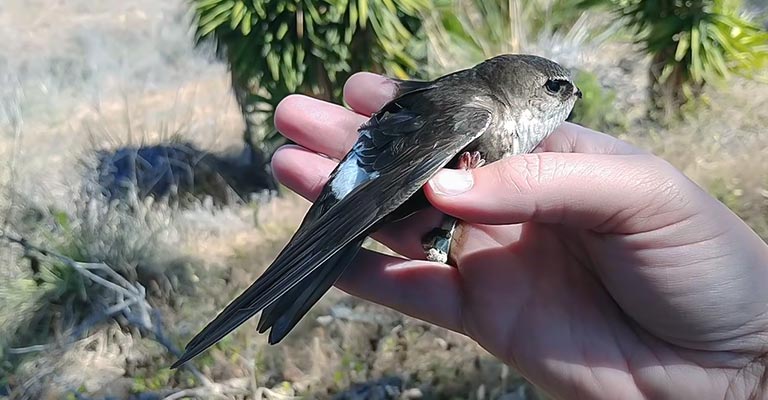
The White-throated Swift (Aeronautics saxatile) boasts a captivating life history marked by unique adaptations, behaviors, and challenges.
From its food choice to breeding habits, this aerial virtuoso has a rich life story that unfolds in the western regions of North America.
Food
White-throated Swifts are consummate aerial hunters, predominantly feeding on flying insects. Their diet comprises airborne prey, including flies, moths, and beetles.
With their exceptional flight skills, they adeptly capture insects mid-air, showcasing remarkable agility and precision.
Their specialized beaks are adapted for capturing and consuming prey in flight, making them efficient and skilled hunters.
Habitat
These birds prefer rocky cliffs, canyons, and rugged terrains for nesting and roosting.
Their habitat selection is often characterized by arid and mountainous regions, where suitable nesting sites and access to flying insects for food are abundant.
Range Map

The White-throated Swift’s range extends from southern Alaska to Baja California, encompassing western North America.
Their distribution map showcases their adaptability to diverse landscapes, emphasizing their presence in coastal and inland areas.
Breeding
Breeding among White-throated Swifts typically occurs in colonies, with individuals exhibiting solid social bonds. The nests are constructed on vertical rock faces and cliff ledges using feathers, plant material, and twigs.
The female lays a small clutch of eggs, and both parents participate in incubation. Once hatched, the chicks are cared for by the parents and often by other non-breeding adults in the colony.
Diseases
Like many bird species, white-throated Swifts can be susceptible to various diseases.
Avian diseases, including respiratory infections and external parasites, may impact their health. Monitoring for signs of illness, such as lethargy or abnormal behavior, is crucial for early detection.
Treatment
When diseases are identified, prompt intervention is essential. Treatment may involve veterinary care, supportive measures like providing appropriate nutrition, and, in some cases, isolation from the colony to prevent the spread of contagious illnesses.
Conservation efforts also play a role in maintaining healthy populations and preventing disease outbreaks.
Conservation
The conservation status of White-throated Swifts underscores the importance of protecting their nesting and foraging habitats.
Conservation initiatives should focus on preserving suitable cliff habitats, minimizing disturbance during the breeding season, and raising awareness about the significance of these birds in maintaining ecological balance.
Monitoring population trends and implementing protective measures are crucial for the long-term conservation of this species.
The life history of the White-throated Swift is a testament to the bird’s remarkable adaptations for aerial life, its social behaviors, and the challenges it faces in an ever-changing environment.
Nesting Habit of White-throated Swift
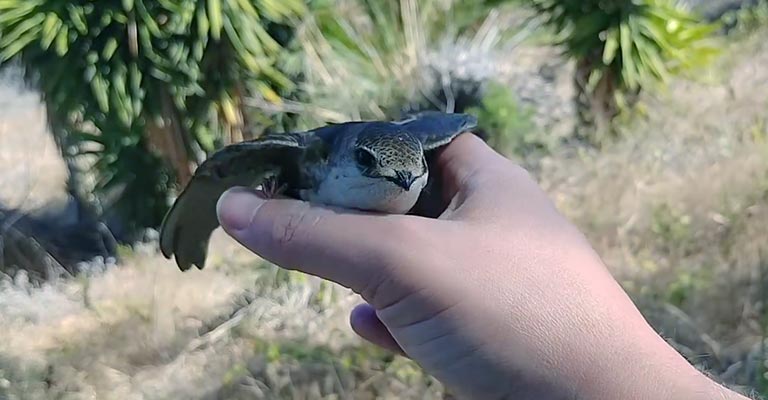
Here’s a table summarizing the nesting details of the White-throated Swift:
| Nesting Details | Facts |
| Clutch Size | Usually 2 to 4 eggs |
| Number of Broods | Often one brood per breeding season |
| Egg Length | Approximately 0.6 to 0.8 inches (1.5 to 2 cm) |
| Egg Width | Around 0.4 to 0.6 inches (1 to 1.5 cm) |
| Incubation Period | Approximately 19 to 21 days |
| Nestling Period | About 28 to 30 days |
| Egg Description | White or creamy, small and elongated |
| Nest Construction | Built on vertical rock faces and cliff ledges, using feathers, plant material, and twigs |
| Parental Involvement | Both male and female participate in incubation and care for the nestlings |
| Nest Site Selection | Prefers cliffs, canyons, and rocky outcrops, often in colonies |
These details provide an insight into the White-throated Swift’s reproductive behavior and nesting habits, emphasizing their adaptability to vertical rock surfaces and their social nesting tendencies.
Make a table on the nesting details of White-throated Swift. Includes facts like Clutch Size, Number of Broods, Egg Length, Egg Width, Incubation Period, Nestling Period, Egg Description, etc.
White-throated Swifts exhibit a unique nesting habit, constructing nests on vertical rock faces and cliff ledges in colonies. Typically laying 2 to 4 small, elongated eggs, males and females actively participate in the incubation process, lasting around 19 to 21 days.
Once hatched, nestlings require approximately 28 to 30 days to fledge. The nests are carefully crafted using feathers, plant material, and twigs, showcasing the bird’s resourcefulness in utilizing available materials.
This communal nesting behavior and preference for rugged terrains highlight the species’ adaptation to challenging environments, contributing to the intriguing life history of the White-throated Swift.
5 Behavioral Habits of White-throated Swift
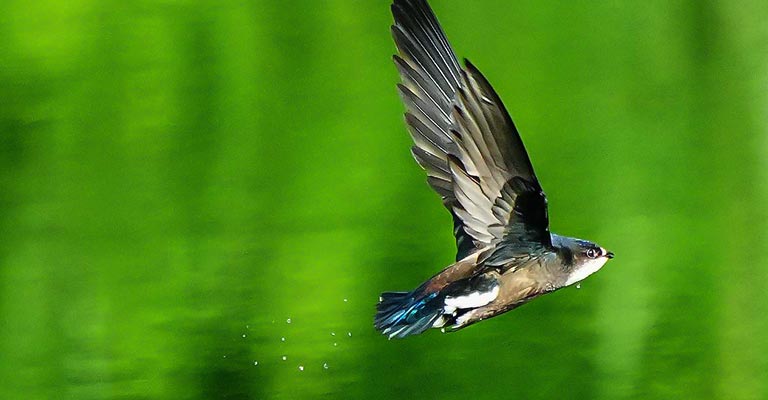
The White-throated Swift, a captivating bird of western North America, displays distinct behavioral habits that contribute to its survival in varied environments.
These behaviors, shaped by evolutionary adaptations, enhance their efficiency in flight, feeding, and social interactions.
Aerial Mastery
White-throated Swifts are renowned for their exceptional flight skills. Their swift and agile aerial maneuvers, characterized by rapid wing beats and sharp turns, allow them to navigate complex landscapes and capture flying insects precisely. This mastery of the air is a crucial aspect of their hunting strategy.
Social Nesting
The species strongly favors social nesting, often forming colonies on vertical rock faces and cliff ledges.
This communal approach provides advantages such as enhanced protection against predators and shared responsibilities in incubating eggs and caring for nestlings, fostering a cooperative breeding environment.
Distinct Vocalizations
White-throated Swifts communicate using high-pitched and chattering vocalizations. These sounds play a role in social interactions, coordination during flight, and signaling within colonies.
Studying their vocal repertoire contributes to a better understanding of their complex social dynamics.
Crepuscular Activity
These birds are crepuscular and are most active during dawn and dusk.
This behavioral adaptation allows them to capitalize on low light conditions for hunting and navigating their rocky habitats, showcasing a strategic utilization of environmental factors.
Territorial Defense
White-throated Swifts are territorial during the breeding season, defending their nesting sites vigorously. Aggressive displays and aerial confrontations are standard as individuals assert and protect their nesting territories.
This territorial behavior is crucial for securing resources and ensuring the success of their breeding efforts.
The behavioral habits of the White-throated Swift underscore its adaptability, social nature, and evolutionary strategies that contribute to its success in the dynamic ecosystems it inhabits.
Studying these behaviors provides valuable insights into avian adaptations and enhances our appreciation for the intricacies of the natural world.
Wrapping Up
The White-throated Swift emerges as a remarkable avian species characterized by distinctive life history traits and behavioral adaptations.
Each aspect contributes to the bird’s survival in diverse habitats, from its aerial mastery and social nesting habits to territorial defense and crepuscular activity.
Understanding these intricacies enhances our appreciation for the role of behavioral adaptations in avian evolution and ecological resilience.
Conservation efforts must prioritize the preservation of their unique habitats and address potential threats to ensure the continued thriving of this fascinating species in the western landscapes of North America. Thank you very much.